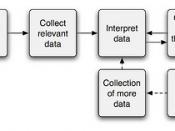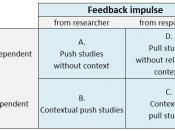Marketing research plays a significant part in the development of marketing plans because it allows the organisation to become less isolated from the key trends and changes, which surround their product. To continue to be successful, organisations must receive information, from the researcher that is clear and accurate. It also has to satisfy your pre-determined goal for your research.
"Marketing research is the function which links the consumer, customer and the public to the marketer through information."
A.M.A definition (McDonald And Gates'1996)
Market research identifies issues that have a direct effect on the organisation, through the analysis of the results. The results and obtained information must be collated and presented in a form that is easy to understand. Instead of raw data, you have a series of graph, charts and tables.
There are three main types of research, diagnostic, descriptive and predictive. Diagnostic research is used when you need to analyse the effectiveness of an advertising campaign.
Descriptive research is fact finding secondary data. You would use this when you planned to sample a section of a target audience for a particular product. Predictive research is about identifying new opportunities in a market place and calculating the effect of marketing decisions. You would use this if the organisation were planning to expand or regenerate their product.
When conducting research, you have to use a sample of your population. The reason why you use a sample is because you can't physically research every single person in the country, unless you are the Government and you are conducting a census. Your sample should consist of people who fit into the research requirements. Sampling is cost and time effective, which are extremely important to the organisation that are commissioning the research because they are anxiously waiting for the results of the research.
The research data, which has been collected can be categorised into two main sections, qualitative research and quantitive research. Usually most research contains particles from both sections.
Qualitative research is when the information is open to broad interpretations. It is not concerned with finding statistics, which relate to the product but focuses on the reasons lying behind certain areas, for example consumer feeling and motivation. Qualitative research is a more flexible approach as it explores customer behaviour, it identifies and analyses their emotions. This research is usually conducted on small samples because the finding will be divers and full of 'richness'. This research cannot be generalised as it deals with complex issues that tend to be unique to the individual, human emotions.
When using Qualitative research, there are several research techniques that you can use. The techniques must be on a more personal scale, in comparison with quantitive research, as the research requires that source of information. Primary data is excellent as it is specifically designed to address the problems identified in the research objectives. Primary data includes information that is 'first hand', as it is collected directly from the respondent. Examples are surveys, group discussions, interviews and observations.
Surveys are an excellent form of researching. The survey has been carefully designed to address your objectives. It can be quick and accurate in pinpointing the information required because there is no room for distraction. Respondents either chose an answer or make their own. It is relatively cheap and less time consuming. The results are excellent to interpret, evaluate and are affectively displayed in several formats. In America, the car manufacturing company Ford was thinking about designing a new truck. The main purpose of the truck was to distribute beverages or chilled canned products. Their questionnaire was used to gather information from the distributors, the mechanics and the drivers. The information was pooled together and presented to Ford. From the gathered information Ford were able to satisfy their brief and designed the "Louisville".
Group Discussions (Focus Groups) is when six to ten people, who are recruited according to the pre-determined criteria, exchange experiences, attitudes and beliefs about certain topics. It is a semi controlled environment and a moderator lead the conversation flow. The whole discussion is recorded and everyone is informed about the recording, following ethical guidelines. With a group environment, the respondents are less intimidated because they are not alone,
"Everyone in the same boat"
(Gordan and Robson 1982)
This allows the atmosphere to relax after the initial tension has diminished. With a group discussion the information is rich in source and in supply. One person will say something and someone else will comment on their view. It is like a stepping stone process for creativity. This process highlights differences between respondents, which helps the producer understand the diverse range of attitudes and emotions that surround their product. I personally have been involved in a group discussion. I was part of a focus group that was used by the B.B.C. The purpose of our group discussion was to talk about our favourite programmes. They planned to use our suggestions and feature them in an advert that explained how the B.B.C was funded. The group consisted of seven males, similar age as myself. The whole discussion was recorded and a moderator led the conversation.
Observational research is when a person, who satisfies the criteria, is being observed and recorded. The observer will note the person's body language and behaviour and will analyse it in order to understand the problem. The observer will either be conducting this research in a controlled or non-controlled environment. A controlled environment would be a room with only the observer and subject present. A non-controlled environment would be a busy street. Most observational research is conducted in controlled environments because less ethic are involved. Ethics are breached when someone is being recorded against their will or are unaware. High street clothing companies, such as Arcadia, Mark and Spencer's and Next all carry out observational research. The research is through a 'mystery/test shopper'. The researcher takes on the role of a customer and rates the staff's performance. Again I have been involved in an observational research campaign. I was asked to look at several different types and styles of packaging for "Southern Comfort" whiskey. The researcher recorded my expressions and feelings towards each packaging idea.
The remaining section from your collected data is quantitive research. This type of research involves a mass collection of measurable information, which is not open to interpretation. This type of research can be conducted through the use of telephone interviews, face-to-face interviews and mail questionnaires. Quantitive research also utilises secondary data sources.
The types of secondary data sources are information that has already exists, from an external body. Government published data, trade press or association files, press articles or report commissioned by independent authorities or watchdogs. However secondary information is complicated, it may take a long time to get relevant information that you can use. The majority of the information may not be relevant to your research. This is an example of low cost research, most sources are available free of charge to the public.
When using quantitve research the methods differ from qualitive methods. Quantitve methods tend to be more impersonal, and direct to the point. Telephone interviews are excellent because the survey 'script' has been designed to combat the issues that the research is trying to find out. The speed of the interview must be fast and last no longer than ten minutes. You have to keep the respondent interested in order to get a response. Kwik Fit uses this method to measure the amount of customer satisfaction. This will allow them to see what areas they need to improve on.
Individual interviews are another form of research. The process can last up to an hour. During this hour the researcher is recording your responses and is able to expand on your answers because a rapport has been built up. This form of research is more common as you see the researcher, with their clipboards on most high streets. Littlewoods carry out this type of research. The want to know their customer's reactions and feelings, in order to provide a high quality catalogue. Researchers will stop people and ask them a few simple questions concerning the catalogue.
Mail questionnaires are a more popular form of research. It involves sending out self-completion surveys to a population sample. The sample is then supposed to fill them out and return them to the researcher. With mail questionnaires you can cover a vast amount of your sample, as you are able to send out thousands of questionnaires. The only problem is that response rate tends to be low,
"Usually between fifteen to thirty-five percent respond"
(Wendy Gordon 1989)
So you have to account for a poor response rate. Many companies use this method to investigate their customers spending habits. Carphone Warehouse sends out questionnaires to all its customers that have recently bought a new phone. The company have tried to combat the problem of poor response rate by offering an incentive. If they return the questionnaire they will receive a voucher giving them ã25 of their next purchase. They also use their existing customers to help increase their customer base. They offer you another money off voucher if you get a friend to buy a phone from them.
With the types of research available, I personally believe in qualitative research because there is a greater need to expand and develop your research. This is useful because it allows your finding to be more accurate and richer in source. When conducting research I suggest that you use both types of data. Secondary data will allow you to build up a background and may even hold some relevant information to your research. The only draw back from secondary research is that there is so much of it available and you are left asking,
"Where do I start?"(Chris Fill 1999)
I suggest that you start by looking at the Marketing Research Society Yearbook. This annual publication has a list of companies and information that is vital to your research. It is impossible to conduct research without using primary data. Primary data is so essential to your research that it holds all the answers to your brief. You have to make sure that the method that you adopt is cost effective and valid to your research.
Marketing research is the most important section of a marketing plan because it decided, due to your findings, whether or not the rest of the plan will be implemented. So if a company wanted to develop a new product and their research found that there is no or little market for that product then they would change their plan in order to implement the research findings and suggestions.
Bibliography
1."Principles of Marketing", Frances Brassington and Stephen Pettitt, Prentice Hall. (2nd Edition)
2."Qualitative Market Research", Wendy Gordon and Roy Langmaid, Gower (1989)
3."Marketing Research", Gilbert A.Churchill, Jr. The Dryden Press. (7th Edition)
4."Marketing Strategy and Management", Michael J.Baker, Macmillan. (2nd Edition)
5."Marketing Communications", Chris Fill, Prentice Hall. (2nd Edition)
6."The Essential Marketing Sourcebook", Ros Jay, Prentice Hall (1998)


